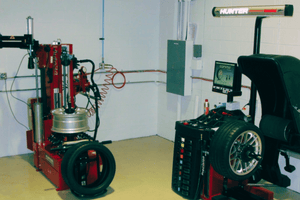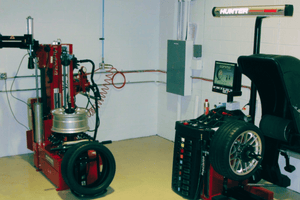Road Force® Tire Balancing
At 60 miles per hour, an average size tire rotates 850 times per minute. At this speed, slight variations in balance, sidewall stiffness or roundness can cause the wheel to literally slam into the pavement 14 times a second. The ultra-sensitive road feel of today’s vehicles gives drivers a hands-on detection of vibration, a warning of potential problems. Unchecked, excessive wheel vibration can result in expensive damages and unsafe driving conditions such as:
- EXCESSIVE TIRE WEAR
- DAMAGE TO SUSPENSION AND STEERING COMPONENTS
- UNSAFE STEERING AND HANDLING
RRT’s Road Force® GSP9700 measures radial and lateral tire forces and provides solutions for solving ride and handling problems such as tire pull and wheel vibration that balancers and wheel aligners cannot fix. Hunter’s Road Force® GSP9700 is endorsed and recommended by BMW, Mercedes and many other vehicle manufacturers and proven by thousands of repair facilities worldwide as the industry standard.
Smooth-rolling tires and wheels can be the difference between having a vibration-free driving experience or a shaky one. If the tire and wheel tolerances are not examined, corrected, or are allowed to “stack up” rather than “cancel out” each other, the possibility of a balance or road force induced ride vibration exists. Because of this, Tire & Wheel Packages don’t ship from the Tire Rack unless they’re Hunter-Balanced and Road Force® approved!
Tires are made up of internal beads, body plies and belts that are encased in rubber, assembled and cured. Alloy wheels are cast, cooled and machined. And even though they both are built to tight tolerances, there is bound to be some unavoidable weight imbalances during the manufacturing process.
When you consider that a typical passenger car tire mounted on an alloy wheel weighs about 40 pounds, it’s amazing that the total amount of imbalance is typically no more than three to four ounces, or about one-half of one percent. So, if the tire and wheel combination isn’t balanced with add-on weights, being off even an ounce or two can cause vibration at highway speeds. Heavier tire and wheel combinations, especially those used on light trucks, require more weights to maintain the same low percentage of imbalance.
The GSP9700 Vibration Control System goes far beyond the traditional capabilities of a wheel balancer. In addition to rectifying the inevitable wheel and tire imbalance, the GSP9700 Vibration Control System also “road tests” the mounted assembly to confirm virtually every aspect of a tire and wheel combination that might contribute to a vibration.
The GSP9700 Vibration Control System includes Hunter’s exclusive Road Force Measurement System to help detect potential tire uniformity causes of vibration that are not balance-related. This system utilizes a “road roller” which applies up to 1,400 pounds (635 kg) of force against the wheel and tire assembly to measure their combined uniformity. This simulated road force test helps verify if the assembly is “round” when rolling under load.
The GSP9700 Vibration Control System can also measure lateral and radial rim runout (out of roundness or side-to-side movement) to identify and separate wheel runout from tire runout. The system then calculates the contributions of the wheel and the tire to a potential vibration and presents the service specialist with easy-to-follow instructions on the appropriate corrective actions.
If the wheel and tire are at the edge of acceptable tolerances, Hunter’s patented ForceMatching(TM) feature is used to align the high point of the tire with the low spot of the rim. This helps maximize ride quality by minimizing the effects of tire force variation and rim runout. If a wheel or tire is found to be out of tolerance, it is replaced with another wheel or tire that is within tolerance.
Once acceptable uniformity has been confirmed, or corrective actions have been completed, the technician can continue with precision wheel balance.





